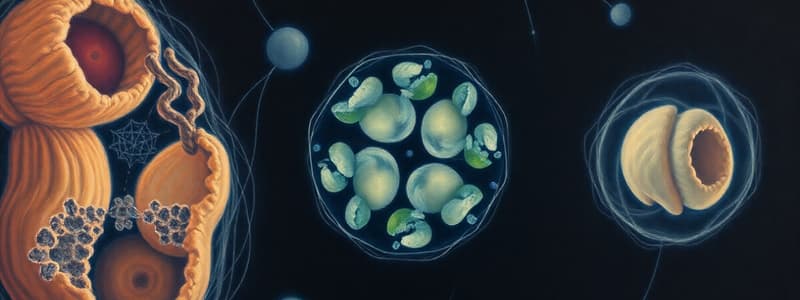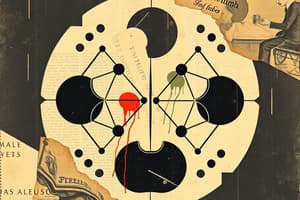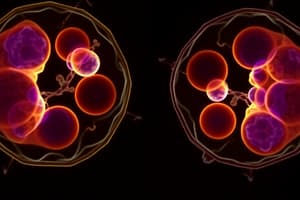Podcast
Questions and Answers
During which phase of meiosis does crossing over occur?
During which phase of meiosis does crossing over occur?
- Metaphase I
- Anaphase I
- Telophase I
- Prophase I (correct)
What is the main difference between mitosis and meiosis?
What is the main difference between mitosis and meiosis?
- Mitosis produces four daughter cells, while meiosis produces two daughter cells.
- Mitosis produces haploid cells, while meiosis produces diploid cells.
- Mitosis occurs only in eukaryotes, while meiosis occurs only in prokaryotes.
- Mitosis produces genetically identical cells, while meiosis produces genetically different cells. (correct)
Which of the following is NOT a phase of mitosis?
Which of the following is NOT a phase of mitosis?
- Prophase
- Anaphase
- Metaphase
- Interphase (correct)
What is the primary function of facilitated diffusion?
What is the primary function of facilitated diffusion?
Which of the following statements about the cell cycle is TRUE?
Which of the following statements about the cell cycle is TRUE?
During which phase of meiosis do homologous chromosomes separate?
During which phase of meiosis do homologous chromosomes separate?
What is the main difference between passive transport and active transport?
What is the main difference between passive transport and active transport?
Which of the following processes is essential for the formation of gametes?
Which of the following processes is essential for the formation of gametes?
Flashcards
Cell Cycle
Cell Cycle
The series of events that cells go through to grow and divide.
Interphase
Interphase
The phase where the cell grows and prepares for division, accounting for 90% of the cycle.
Meiosis
Meiosis
A type of cell division producing four genetically different haploid gametes.
Crossing Over
Crossing Over
Signup and view all the flashcards
Mitosis
Mitosis
Signup and view all the flashcards
Cytokinesis
Cytokinesis
Signup and view all the flashcards
Passive Transport
Passive Transport
Signup and view all the flashcards
Active Transport
Active Transport
Signup and view all the flashcards
Study Notes
Cell Cycle
- The cell cycle describes the process cells use to grow and divide.
- It's composed of interphase (90% of the cycle for typical cells) and M phase (mitosis or meiosis).
- Interphase includes G1 (growth), S (DNA replication), and G2 (organelle replication) phases.
- The M phase is where mitosis or meiosis happens, followed by cytokinesis (cytoplasm division).
Meiosis
- Meiosis produces four unique haploid gametes.
- It involves two divisions (meiosis I and meiosis II).
- In meiosis I: homologous chromosomes separate; crossing over (gene shuffling) occurs in prophase I, and independent assortment (random alignment) happens in metaphase I.
- In meiosis II: sister chromatids separate, leading to four unique haploid cells.
- It’s crucial for sexual reproduction, promoting genetic diversity.
Mitosis
- Mitosis produces two identical diploid daughter cells.
- It's essential for growth and repair.
- It consists of prophase (chromosome condensation, spindle fiber formation), metaphase (chromosome alignment), anaphase (sister chromatid separation), and telophase (nuclear membrane reformation).
- Cytokinesis completes the process, dividing the cytoplasm.
Cell Transport
- Cell transport moves substances across the cell membrane.
- Passive transport requires no energy; examples are diffusion (movement from high to low concentration), osmosis (water movement), and facilitated diffusion (using transport proteins).
- Active transport requires energy (ATP) to move substances against their concentration gradient (low to high).
- Bulk transport (endocytosis and exocytosis) involves large molecules' movement in or out of the cell.
Mitosis vs. Meiosis (Comparison)
- Mitosis creates identical cells, essential for growth and repair, with one division.
- Meiosis produces unique cells for sexual reproduction with two divisions, significantly increasing genetic variation.
- Meiosis yields four haploid cells; mitosis yields two diploid cells.
Studying That Suits You
Use AI to generate personalized quizzes and flashcards to suit your learning preferences.




